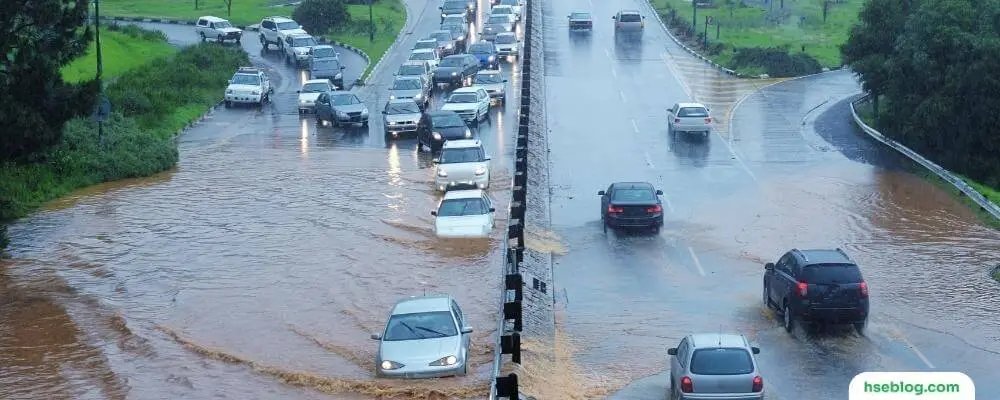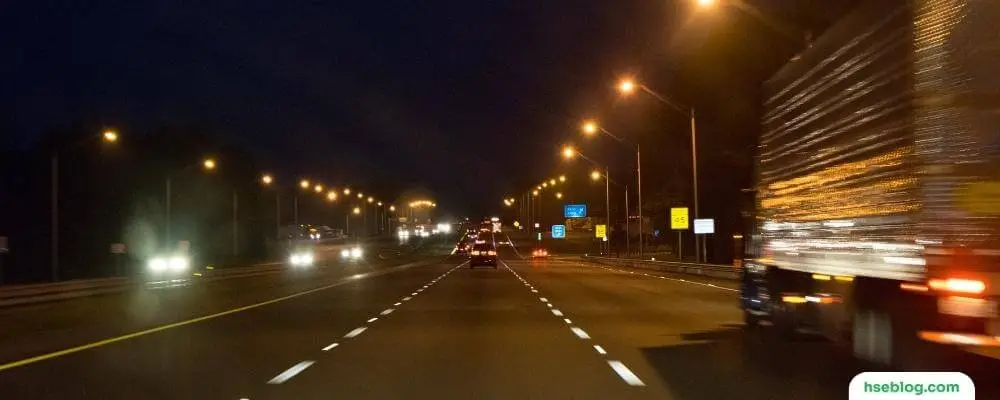Navigating the complex maze of roadways requires more than a keen eye and adept handling of a vehicle; it demands a comprehensive understanding of both driving and road safety hazards, along with the measures that can be taken to control them. Each journey we embark upon, whether a short trip to a local supermarket or a long cross-country adventure, presents a unique blend of risks and challenges. However, armed with knowledge and understanding, these potential dangers can be effectively managed, ensuring not only our safety, but the safety of others sharing the road with us.
In this blog post, we delve into an array of hazards that exist within our driving environments, spanning weather conditions, driver behavior, road conditions, vehicular issues, and the broader scope of road safety, including road design, user behaviour, vehicle standards, and the surrounding environment. More importantly, we will discuss the control measures that can be adopted to mitigate these risks.
As the saying goes, “Forewarned is forearmed.” By understanding the risks and hazards we may encounter on the road, and by knowing the right control measures to employ, we can contribute to a safer and more secure driving environment for everyone. So, let’s buckle up and begin our journey into the world of driving and road safety hazards and their control measures.
Driving and Road Safety Hazards and Control Measures
Driving and road safety hazards can pose significant risks to drivers, passengers, and pedestrians. It’s essential to be aware of these hazards and take appropriate control measures to minimize accidents and ensure road safety. Here are some common driving and road safety hazards, along with control measures:

Driving Hazards and Control Measures:
Driving hazards refer to threats or conditions that could lead to road accidents or unsafe driving situations. These may include weather conditions, other road users, the driver’s physical and mental state, road conditions, and vehicular issues. Control measures are the strategies or methods employed to mitigate these risks.
1. Weather Conditions
Certain weather conditions can greatly increase the risk of a car accident. Rain, snow, fog, sleet, and hail can reduce visibility and cause the roads to become slippery. Control measures include using appropriate lights, not just to see, but to be seen by other drivers. In conditions of reduced visibility, it’s important to slow down, as the stopping distance can be increased. If the weather conditions are too dangerous, avoid traveling until they improve. In snow or icy conditions, using snow tires or chains can increase traction and reduce the chance of skidding.
2. Other Road Users
Other road users, whether they are drivers, pedestrians, cyclists, or animals, can all present hazards. Defensive driving involves being aware of others, anticipating possible problems, and reacting in time. It involves following speed limits, keeping a safe distance from the vehicle in front, using mirrors and signals properly, and giving way to pedestrians at crossings.
3. Driver’s Physical and Mental State
A driver’s state of health and mind can greatly affect their ability to drive. Fatigue, distraction, and impairment from alcohol or drugs can slow reaction times and lead to poor decision-making. Regular breaks on long journeys can prevent tiredness. Mobile devices should be avoided when driving. Never drive when under the influence of alcohol or drugs, and if feeling emotionally unstable or stressed, it is better to avoid driving.
4. Road Conditions
Poor road conditions, such as potholes, loose gravel, or oil slicks can lead to a loss of vehicle control. Drivers should adjust their driving speed based on the road conditions and keep a safe distance from the vehicle in front. Hazardous conditions should be reported to authorities so they can be addressed.
5. Vehicular Issues
Issues with the vehicle itself, such as tire blowouts, brake failures, or mechanical breakdowns can lead to accidents. Regular vehicle maintenance is essential, including routine checks of tire pressure, fluid levels, and brakes. Having an emergency kit, including a spare tire, jack, and basic tools, can help address minor issues that could otherwise leave you stranded.
6. Improper Load Distribution
For vehicles carrying heavy or large loads, improper load distribution can make the vehicle unstable and harder to maneuver. The load should be distributed evenly across the vehicle’s axles and secured properly to prevent it from shifting, which could cause the vehicle to tip over or lose control.

7. Night Driving
Driving at night poses increased risks due to decreased visibility and increased likelihood of encountering drivers who are drowsy or under the influence. Using your vehicle’s headlights and taillights is crucial for being seen by other road users. Slowing down and increasing following distances can help provide more time to react to unexpected situations.
8. High-speed Areas or Highways
Accidents on highways tend to be more serious due to the high speeds involved. Sticking to the speed limit, using turn signals for lane changes, maintaining a safe following distance, and staying aware of blind spots are critical when driving in these areas.
9. Teen Drivers
Young and inexperienced drivers are more likely to be involved in accidents. Graduated licensing systems can help new drivers gain experience in lower-risk conditions before moving onto more complex driving situations. Driver’s education programs can also provide new drivers with the knowledge and skills they need to drive safely.
10. Elderly Drivers
Aging can lead to decreases in vision, cognitive ability, and motor skills, all of which are critical for safe driving. Regular medical check-ups can help ensure an older driver is still fit to drive. Public transportation, ride-sharing services, or rides from friends and family members can provide alternatives to driving for those who can no longer drive safely.
11. Rural Roads
These roads often lack proper lighting, have high speed limits, and may have wildlife that can wander onto the road. Drivers should adjust their speed to the conditions, use high beams when there’s no oncoming traffic to increase visibility, and be extra vigilant at dawn and dusk when wildlife is most active.
12. Aggressive Driving and Road Rage
These behaviors can quickly escalate and result in serious accidents. Traffic laws should be enforced to deter aggressive driving, and educational campaigns can help promote more courteous and respectful driving behaviors.
Remember, the key to safe driving is always staying alert, aware of potential hazards, and taking appropriate precautions.

Road Safety Hazards and Control Measures:
Road safety hazards refer to road conditions or situations that can lead to accidents or injuries. This could be related to road design, user behavior, vehicle standards, or the surrounding environment. Control measures refer to ways of managing or eliminating these hazards.
1. Poor Road Design
This refers to poorly planned or maintained roads, lacking necessary signage or lighting, or lacking essential facilities such as pedestrian walkways or bicycle lanes. Control measures include conducting regular audits to identify and address such problems, installing effective signage to guide motorists, ensuring adequate lighting for night visibility, providing pedestrian and bicycle facilities, and incorporating calming measures like speed humps and roundabouts to slow down traffic.
2. Reckless User Behavior
Speeding, driving under the influence, failure to use seatbelts or helmets, and distracted driving (such as using a cell phone while driving) contribute to many road accidents. Stricter enforcement of traffic laws and regulations, public awareness campaigns to educate road users about the dangers of reckless behaviors, and employing technology like speed cameras and breathalyzers can help control such risks.
3. Vehicle Standards
Vehicles not meeting safety standards can be a potential hazard on the road, leading to mechanical failures and accidents. Regular vehicle inspections to ensure adherence to safety standards, stringent safety regulations for vehicle manufacturers, and promoting safety-enhancing technology like anti-lock braking systems (ABS) and electronic stability control (ESC) are effective control measures.
4. Surrounding Environment
Certain areas, such as uncontrolled intersections, school zones, and areas with high pedestrian traffic, can be hazardous. Installing traffic lights or pedestrian crossings, implementing school zone speed limits, and designing roads with safety barriers to separate different types of traffic can help mitigate these hazards.

5. Inadequate Infrastructure
Poor road infrastructure contributes to accidents in many regions, especially in developing countries. Investing in infrastructure upgrades, prioritizing pedestrian and cyclist safety in urban planning, and implementing overpasses, underpasses, and traffic calming measures can help enhance safety.
6. Lack of Road Safety Education
The lack of knowledge about traffic rules and safe driving practices can lead to dangerous situations on the road. Public education campaigns, integrating road safety into school curricula, and ensuring driver’s license applicants have proper knowledge before being licensed are key control measures.
7. Unpredictable Pedestrian Behavior
Pedestrians not following traffic rules or behaving unpredictably can cause accidents. Pedestrian education campaigns, adequate pedestrian facilities such as sidewalks and crossings, and improving the visibility of pedestrians (for example, by encouraging the use of reflective clothing) can help control these risks.
8. Commercial Vehicles and Public Transport
Commercial and public transport vehicles often operate differently than regular passenger vehicles, creating potential hazards. Specialized training for commercial vehicle drivers, regular vehicle inspections to ensure they are in good condition, and enforcing strict operating hours and load limits can help reduce these risks.
9. Motorcyclists and Bicyclists
Due to their smaller size and less protection, motorcyclists and bicyclists are more vulnerable in accidents. Enforcing helmet use, creating designated lanes for motorcyclists and cyclists, and education campaigns aimed at these road users and motorists to promote mutual respect and understanding can enhance safety.

10. Road Construction Zones
Construction zones can be particularly hazardous due to changes in traffic patterns and the presence of construction equipment and workers. Ensuring clear signage to direct traffic, reducing speed limits around construction zones, employing traffic flaggers to guide road users, and planning construction to minimize disruption to traffic can help control these hazards.
11. Emergency Vehicles
Emergency vehicles often must travel at high speeds and may disregard certain traffic rules to reach their destinations quickly, potentially leading to accidents. Specialized driver training for handling emergencies, public education campaigns to inform road users about what to do when encountering an emergency vehicle, and technologies to alert drivers of approaching emergency vehicles can help reduce these risks.
Each hazard represents unique challenges, and addressing them effectively requires a comprehensive, multi-faceted approach. The ultimate goal is to ensure the safety of all road users.
Conclusion
In conclusion, the journey to ensuring road safety is continuous, demanding all road users’ attention and responsibility. Recognizing driving and road safety hazards, ranging from weather conditions, driver behaviors, and vehicle standards to broader road safety issues, is a vital first step. However, true change emerges when we employ effective control measures against these hazards. This includes adherence to traffic laws, consistent vehicle maintenance, thoughtful infrastructure development, robust driver education, and overall safety culture and respect on the roads.
By proactively understanding and addressing these risks, we can significantly reduce road accidents and injuries, safeguarding our journeys and making every trip a safer experience. Let’s remain vigilant and drive the change towards safer roads, one mile at a time.

